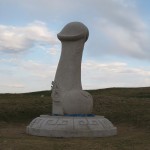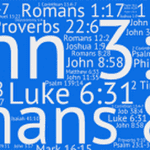I can’t believe I am diving into this linguistic swamp again, but here goes. Recently, I’ve been engaging in some online discussions with polytheists and the “Pagan enough” debate was aroused, of course, and it got me thinking.
One person in particular, L.S., insisted that the term “Pagan” is meaningless and should be abandoned — an argument that I find particularly frustrating as someone who identifies primarily as Pagan, not with any specific Pagan tradition. Someone else wrote that “Pagan” is comparable to “Christian” in that both terms are “umbrella” terms. (I would point out that there are also people who identify primarily as Christian, as opposed to some specific Christian denomination.)
Anyway, L.S., responded that, unlike “Pagan”, at least there is some agreement as to what the term “Christian” means, which he went on to define as someone “who believes in (follows the teachings of) Christ/Jesus”. I pointed out that there are Christians who adopt other definitions. Some insist (rather emphatically) that belief in the existence or teachings of Jesus is not what defines one as Christian, but rather a salvific experience of the grace of God through Jesus. Also, I have encountered both Protestants and Catholics in my community, near Chicago, who use “Christian” to mean “Protestant”, which I find strange, but there it is. Anyway, as a former Mormon, I assure you there is not a consensus about what “Christian” means. L.S. responded, “it is pretty hard to refute that, at its most basic, Christianity places Jesus as a pretty important figure.” The comments closed before I was able to respond, but it occurred to me that L.S. may have hit on something.
A lot of definitions of “Pagan” have been proposed, but every time there is someone who points out that one or more elements of the definition do not apply to them. For example, Isaac Bonewits claims that the “core Neopagan beliefs include (1) a multiplicity of deities of all genders, (2) a perception of those deities as both immanent and transcendent, (3) a commitment to environmental awareness, and (4) a willingness to perform magical as well as spiritual rituals to help both ourselves and others.” Well, I know the last one doesn’t fit me at least. Anyway, L.S.’s comment that Christian means you believe that Jesus is “a pretty important figure” made me think: “And contemporary Pagans are people who think ancient pagans are pretty important people.” Or to articulate it a little better: “Contemporary Pagans are people who look to ancient paganism for inspiration.” Or perhaps even better: “Pagans look to pre- and non-JCI cultures, myths, and religious practices for inspiration.” How about that? I wonder if there will be many people who claim to be Pagans who cannot agree on that at least. I think it has potential.
The discussion with the polytheists also got be thinking about the difference between hard polytheism and other forms of Paganism. I think the growth of hard polytheistic and reconstructionist Paganism is a step away from real live nature, which is increasingly central to what Paganism means to me. Polytheistic Paganism is sometimes called “deity-centered”, in contrast to “earth-centered paganism”. And this is a distinction which many polytheists recognize and embrace. In fact, I have seen many polytheists emphatically insist that they are not “earth-centered”. This seems very strange to others, for whom “Pagan” equals “earth-centered”.
Please take note, this is not about me telling polytheists that they are not Pagan enough. In fact, I think polytheists are well justified in calling themselves “Pagan”. If there is anything that distinguishes ancient paganisms from most contemporary Western forms of religion it is polytheism — not any kind of ecological awareness, which is really a modern phenomenon. So the question then becomes, how are we to distinguish earth-centered Paganism if “Pagan” is to be treated as an umbrella term. I propose that the answer is that earth-centered Pagans (re-)embrace the term “Neopaganism”.
When I first came to Paganism, I identified intentionally as a “Neopagan”. I emphasized the Neo- prefix because I recognized that the Paganism I identified with was something new. It was created in the 1960s and 1970s in the America, and, while inspired by ancient motifs, was intentionally modern or post-modern. I was less interested in reconstructing a pagan past, and more interested in constructing a Neopagan future.
Interestingly, it was the term “Neopagan”, not “Pagan”, that was first used to describe our community (by Tim Zell). As Reconstructionism grew in the community, the Neo- prefix was dropped — I think appropriately. If you are attempting to reconstruct a Pagan past, then you are more of a “Retro-Pagan” (thanks Pagan Princess for the term) than a Neo-Pagan (but I don’t expect that term to catch on). Anyway, the term “Neopagan” has become something of an epithet, especially among polytheists, but I really think earth-centered Pagans need to reclaim it.
It seems to me that, unlike “Pagan”, “Neopagan” is defined first and foremost by the belief that nature is sacred, which I will call for brevity’s sake, “earth-centeredness”. The “center” here refers to the place which is most sacred (i.e., the axis mundi). “Earth-based” and “nature religion” are close enough to be synonyms or my purposes. This is often expressed in theological terms of immanence or pantheism, but there are not necessary. While polytheistic Pagans locate what is most sacred in deities (who may be a part of nature), Neopagans locate what is most sacred in nature (of which deities may be a part). It is a difference of emphasis. And I would argue that this earth-centered orientation is something new, something that was not characteristic of ancient paganisms.
This definition of Neopaganism I think has its support. Helen Berger, author of the Pagan Census, writes in her book, Voices from the Pagan Census, in response to the question, “What is Neo-Paganism?”: “Neo-Pagans define themselves as practicing an earth-based spirituality.” Or consider, Oberon (Tim) Zell, who invented the term “Neopagan”, and recently, at the 2012 Pantheacon, defined Neopaganism succinctly as “green religion”. Every definition of Neopaganism I have read at least includes an earth- or nature-focus as one a few elements. I therefore take the earth-centeredness of Neopaganism as axiomatic.
It is no coincidence, I think, that Neopaganism and the environmental movement grew up together. The following events all occurred during a period from 1967 to 1973 (Neopagan events are italicized):
The founding of Feraferia (1967)
The founding of NROOGD (1967) (Sara Pike marks these first two events as the beginning of the Neopagan movement)
The founding of the Church of All Worlds by Tim Zell who later coins the term “Neopagan” (1967)
Lynn White’s publication of “The Historical Roots of Our Ecological Crisis” (1967)
Isaac Bonewits joins the RDNA which led the organization to to become more explicitly Neopagan (1968)
CAW begins publishing the Green Egg newsletter around which a Neopagan community begins to coalesce (1968)
The photographing of the famous “Earthrise photo” by the Apollo 8 crew showing the Earth rising from the horizon of the moon, which some theorize helped humans realize the fragility of their home (1968)
The height of the American counterculture movement (1968)
The Whole Earth Catalog is published (1968-1972)
The Pagan Way is founded, emphasizing the celebration of nature over occultism (1969-1970)
Mother Earth News founded (1970)
The first Earth Day (1970)
Significant expansion of the Clean Air Act (1970)
Tim Zell publishes his article “Theagenesis: The Birth of the Goddess” which articulates a Gaia theory several years before James Lovelock (1971)
A talk given by Julia Carter Zell (of the Church of All Worlds) at the WorldCon science-fiction convention in Los Angeles marks the beginning of the Goddess religion movement (1971)
Arnold Toynbee publishes “The Religious Background of the Present Environmental Crisis” (1972)
The Council of Earth Religions is formed as one of the first attempts at Pagan ecumenicalism (1973)
Aidan Kelly publishes a Pagan calendar with the names which became the standard for the Neopagan Wheel of the Year (1973)
The signing of the Endangered Species Act (1973)
The release of The Wicker Man film (1973)
While many other religions, like Christianity and Buddhism, may be becoming more ecological, no other non-indigenous religion that I am aware of has earth-centeredness as its first principle. Some polytheists seem to believe that what characterizes Neopaganism is some kind of theological monism. It is natural that deity-centered polytheists would attempt to define Neopaganism in terms of its relation to deity. But monism is not common a defining characteristic in Neopagans’ self-understanding, like earth-centeredness is.
Of course, someone can be Neopagan and something else, like a Wiccan, a witch, a Druid, a shaman, a Goddess worshiper, a ceremonial magician, a humanist, or a Unitarian, in which case earth-centeredness may not be their first principle. But I would still argue that, if they identify as Neopagan, then earth-centeredness must be first principle of their Neopaganism. For example, I am a Jungian Neopagan, but it is my Neopaganism, not my Jungianism, that makes me earth-centered.
It suppose it even possible to be a hard polytheist and a Neopagan. But to the extent that the polytheistic focus on deities draws attention away from things like dirt, wind, rain, and that very real tree in your backyard, then I argue that it is drawing attention away from nature (regardless of whether polytheists insist that their gods are somehow part of nature). Consequently, I believe those polytheists who distinguish themselves from Neopaganism are right to do so.
Is this me trying to establish a “Neopagan orthodoxy”? Maybe. Although, by “orthodoxy” I do not mean what is “right”, but rather an agreed communal meaning. In other words, I am not saying there is only one right way to be Neopagan, and everyone else is wrong. But rather, I am suggesting that this idea can be something around which we can consolidate our community. Every community must engage in some form of boundary maintenance in order to create a sense of shared identity. And I would like to see a consensus grow up around the proposition that “Neopagan” means you identify as “earth-centered” or practice a “nature religion” or something very close to that. And, of course, it also means that you are “Pagan”, which according to my definition above, means you look to ancient paganism for inspiration.















